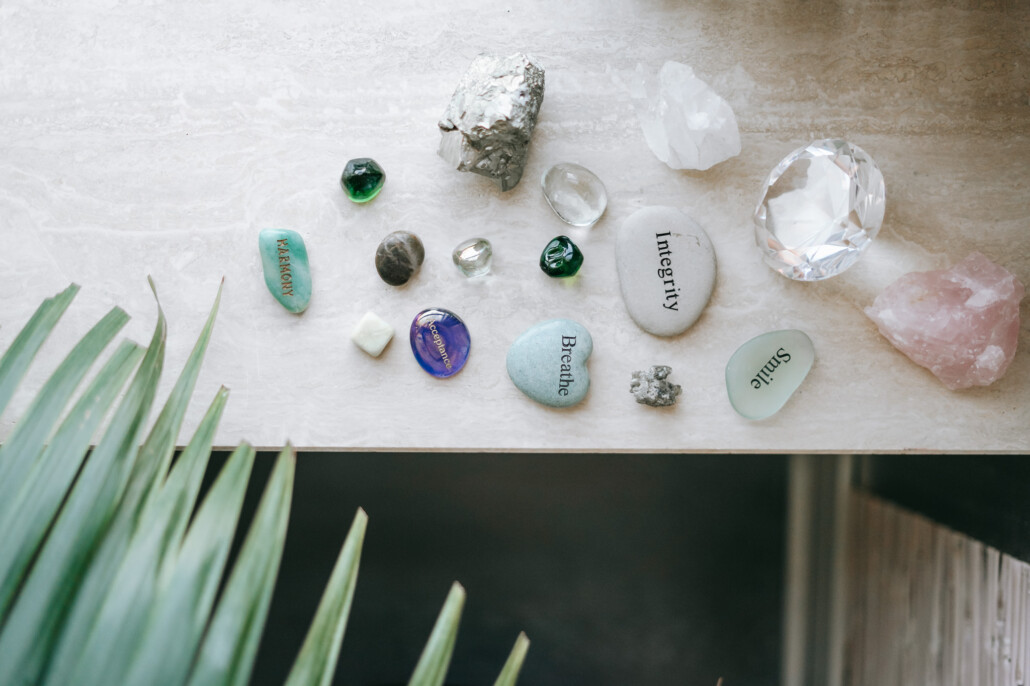I’ve often mused on how my spiritual needs have evolved through each passage of life, and how at every phase there are powerful spiritual tools to center and elevate.
Using these spiritual tools marks the beginning of a process of emotional healing and personal growth, helping us confront difficult feelings as a natural part of our journey.
In our youth, we’re often driven by ambition, the pursuit of love, and the creation of our little universes. But as we blossom into our fabulous fifties and beyond, our focus subtly shifts.
Our gained wisdom pushes us to seek deeper meaning, richer connections, and a tranquil sense of being that resonates with our soul’s rhythm. It’s a time when spirituality takes on a new hue, glowing ever brighter.

Our spiritual side needs attention. Which spiritual tool brings you peace?
If you are feeling a gap in your spiritual side, I’d love to share some advice. These are some of the most profound spiritual tools that have impacted me as well as many other women I’ve had the pleasure of knowing. These are not just practices but mental shifts. I recommend every single one!
Introduction to Spiritual Growth
Spiritual growth is a beautiful, lifelong journey—one that invites us to look inward, nurture our inner self, and discover a deeper understanding of both ourselves and the world around us. As we move through everyday life, it’s easy to get swept up in routines and responsibilities, but prioritizing our spiritual journey brings a sense of balance, harmony, and peace that radiates through every aspect of our lives.
Embracing powerful spiritual tools and practices is essential for cultivating self-awareness, self-love, and inner peace. These tools help us navigate the transformation process, allowing us to let go of emotional pain and make space for our true nature to shine. Whether it’s through quiet reflection, time in nature, or mindful rituals, each step we take on our spiritual path brings us closer to our authentic self.
Remember, spiritual growth isn’t about reaching a final destination—it’s about the ongoing process of self-discovery, compassion, and understanding. By weaving these practices into our daily routine, we create a life filled with meaning, connection, and a profound sense of peace.
Foundations of Spiritual Life
The foundations of spiritual life are rooted in a deep understanding of spiritual principles and a commitment to living with intention. At the heart of this journey is the cultivation of god consciousness—a gentle awareness of the interconnectedness of all living things and the sacredness of every moment. When we recognize that we are part of something greater, our sense of purpose and belonging deepens.
Spiritual life calls us to take personal responsibility for our own growth and well-being. This means embracing spiritual practices such as meditation, guided meditation, and deep breathing as part of our daily routine. These practices help us connect with our true self, quiet the mind, and foster a sense of inner peace and understanding.
To walk the spiritual path is to be fully present, to let go of fear and outdated hopes, and to trust in the wisdom that arises from within. Each moment offers an opportunity to align with our values, embrace our true nature, and experience the peace that comes from living authentically. By nurturing these foundations, we create a spiritual life that is rich, meaningful, and deeply fulfilling.
Spiritual Tool 1: Find Strength in Acceptance
Acceptance, my lovely readers, is not about giving up or surrendering to fate. It’s about embracing the reality of our lives with grace and understanding. It’s a recognition that while we cannot control every aspect of our journey, we hold the power in how we respond to life’s twists and turns, including how we process and regulate our emotion.
Darlings, I want to share with you a story of strength, not the kind that roars, but the kind that whispers and sustains us through life’s unexpected turns. It’s a story about acceptance, a powerful tool in our spiritual journey, especially as we embrace the wisdom of our years and learn to release and heal our emotion along the way.
I’ve told the story of my experience in the sacred labyrinth before. When I think of it, I recall walking through the labyrinth on a path that twisted and turned, much like the journey of life itself.
I entered with a heart full of questions and picked a stone, hoping it would symbolize the strength I sought. I envisioned myself holding a stone inscribed with the word “power,” a testament to the emotional fortitude and the emotion I yearned to manage and accept.
However, the universe had a different plan.
Accepting “Acceptance”
The stone I selected bore the word “acceptance.”
At first, this felt like a gentle letdown. But, as I pondered over it, the profound truth of acceptance began to unveil itself to me.
Acceptance, my lovely readers, is not about giving up or surrendering to fate. It’s about embracing the reality of our lives with grace and understanding. It’s a recognition that while we cannot control every aspect of our journey, we hold the power in how we respond to life’s twists and turns.
And life really knows how to twist. By the time we reach our fabulous fifties and beyond, we’ve lived through many changes. We’ve loved, lost, celebrated, and mourned. We’ve watched as our bodies changed, our relationships evolved, and our careers took unexpected turns. Each of these experiences is a lesson in acceptance. Accepting the natural progression of life, the ebb and flow of our relationships, the shifts in our professional paths – it’s all part of the dance of life. Acceptance helps us heal emotional wounds and supports our recovery from loss or change, allowing us to move forward with renewed strength.
The dance of acceptance.
How to choose acceptance daily
It starts with mindfulness, acknowledging our feelings and thoughts without judgment. It’s about counting our blessings, recognizing the beauty and gifts that each day brings, even amidst challenges. And importantly, it’s about releasing the tight grip of control, understanding that some things are simply beyond our reach.
Choosing acceptance doesn’t mean we stop dreaming or striving for better. It means we approach our goals with a heart at peace, knowing that our best-laid plans might need to adapt to life’s unpredictable nature. It’s a delicate balance of effort and ease, a dance between doing and being.
The path to acceptance, much like my unexpected stone, may not be what we initially seek, but often, it turns out to be exactly what we need. It teaches us resilience, patience, and the courage to face each day with an open heart. And in that openness, we find our true strength.

After my experience in the sacred labyrinth, I have connected to a many crystals and rocks, some with inscriptions like the “acceptance” rock from my story.
Spiritual Tool 2: The Joy of Simplicity
A little known spiritual tool is Simplicity. Creating a simpler lifestyle refreshes and revitalizes the soul. Simplicity doesn’t just mean tossing out unused clothes or household decorations. It also applies to our schedule and our routines.
By embracing simplicity, we free up emotional energy that can be redirected toward deeper spiritual growth and connection.
Simplicity in Belongings
Let’s start with our belongings. Simplifying our possessions is essential to feeling peace. You must let go of what no longer serves you. Begin by decluttering your home, keeping only what is necessary or brings joy. I love following the Konmari method. Darlings, it’s astonishing how liberating it feels to be surrounded by fewer but more cherished items. A decluttered space can delight the senses—sight, sound, and touch—creating an environment that fosters mindfulness and calm. Each piece in my home now tells a story, a memory, or brings a smile.
Simplicity in Scheduling
Then there’s our schedule. Once packed to the brim with commitments, I learned to say “no”, and to prioritize what truly matters. It’s about quality, not quantity. I cherish long walks, coffee with a dear friend, or quiet evenings with a good book and my Ultimate Concierge. A slow, mindful day is usually chosen instead of a calendar crammed with engagements. This simpler schedule has opened up space for spontaneity and for life’s unplanned joys to seep in.
By simplifying my schedule, I’ve also noticed better sleep and an overall sense of well-being.
Simplicity in Routines
Our daily routines can also be simplified. Over the years, I’ve adopted rituals that bring tranquility and balance. Mornings are no longer a race against the clock but a serene time for meditation or a gentle yoga session. Evenings are for reflection and gratitude. This simplicity in my daily routine brings a rhythm that is both soothing and energizing.
By simplifying daily routines, you can reduce stress and promote a greater sense of tranquility in your life.
Simplicity Makes Room for More
Adopting a life of simplicity isn’t about having less; it’s about making room (emotionally and physically) for more – more peace, more joy, more meaningful connections, and the more profound experiences.

Simplifying life makes space for more connection and growth.
Spiritual Tool 3: Meditation and Mindfulness
I remember a time when the concept of meditation seemed distant, almost elusive. My days have always been filled to the brim, leaving little room for quiet. But as the pages of my life turned, bringing with them the wisdom of experience, I discovered the magic of stillness. Meditation and mindfulness are a sanctuary, a place where I can connect with my inner self, and dear readers, it is imperative that you connect with YOU.
Take time to meditate and explore different meditation techniques, such as guided practices, breathing exercises, or using apps and videos, to enhance your spiritual growth and experience the many health benefits meditation offers.
Here is more reading on implementing meditation.
What Meditation Isn’t
Adopting a meditation practice wasn’t without its hiccups. Like many women, I struggled to quiet my mind, to find that elusive state of peace. But then, I learned a valuable lesson about what meditation ISN’T. Here’s the secret, meditation isn’t about silencing our thoughts. It’s about observing them without judgment and viewing our thoughts and feelings with kindness and understanding. Trust me, this takes practice and is worth it.
Through meditation, we can also begin to access the subconscious mind, allowing us to heal deep-seated emotional patterns and support our spiritual growth.
Mindfulness: Be Here Now
Mindfulness, on the other hand, is the art of being fully present. This spiritual tool is about savoring each moment, embracing the beauty of the ordinary. I practice mindfulness in the simplest of ways – feeling the warmth of my morning coffee, listening to the melody of birds, or simply being aware of my footsteps as I walk through the garden and appreciating life as it unfolds.
By practicing mindfulness, I invite light into my everyday moments, allowing it to foster inner peace and clarity.

Meditation and mindfulness are some of the best spiritual tools!
Spiritual Tool 4: Self-Love and Physical Wellness
A common sentiment among women over 50 is a shared feeling of invisibility. Self-love and physical wellness are spiritual tools we all must wield. Self-love is a topic close to my heart, as it touches on the feelings of loneliness, the sense of invisibility, and amplifies the ever-present glimmer of hope.
A girlfriend once told me walking down the street, it seemed as though the world was looking right through her, a stark contrast to the vibrant, seen, and acknowledged life she was familiar with. Loneliness and feeling invisible can cast a spiritual shadow. Self-love and physical wellness are a great balm if you are having these feelings.
Embracing self-love empowers you to take responsibility for your own life and spiritual journey, helping you find meaning and growth even in challenging times.
Choosing Self-Love
Self-love is about looking in the mirror and loving the person we see, with all her stories, scars, and triumphs. It’s about taking the time to care for ourselves, to treat ourselves with the same compassion and kindness we so readily offer to others. Sometimes, self-love means healing from the pain of things we once hoped for but never received, and finding peace with those unfulfilled expectations. Self-love is the antidote to invisibility; it’s a declaration that we see ourselves, even if the world doesn’t.
Physical Wellness as a Foundation
Physical wellness, on the other hand, is the tangible expression of self-love. Moving our bodies is a spiritual tool, not just for the sake of health, but as an act of love. I remember connecting with Michelle Spadafora, the founder of Faithful Workouts, who has been in the fitness industry for over 35 years. Her passion for helping people get strong, both physically and spiritually, was infectious. She reminded me that every step we take, every stretch, every dance move, is a step towards loving ourselves.
Physical wellness also supports the healing of both body and spirit, allowing us to release negative emotions and embrace personal growth.
Combating Loneliness and Finding Hope
If you are feeling lonely, physical activity becomes a great friend. To get right to the point, moving your body is essential for emotional and spiritual well-being. It connects us to our bodies, reminds us of our strength, and often, leads us to communities of like-minded souls. Whether it’s a yoga class, a walking group, or a simple daily routine at home, these activities are small acts of hope, affirmations that we are still here, vibrant and full of life.
Dear reader, dance in your living room, take brisk walks in the park, and stretch under the open sky. Look at yourself in the mirror and smile at the incredible woman looking back. When doing this, I know you’ll find joy, visibility, and a renewed sense of hope.
Navigating Successful Life Transitions
Life is a series of transitions—some expected, others arriving like a sudden breeze. Navigating these changes with grace requires adaptability, resilience, and a willingness to welcome new ideas and experiences. During times of transition, spiritual tools become our anchors, helping us find clarity and strength amid uncertainty.
Powerful spiritual tools such as meditation, journaling, and self-reflection offer us a way to pause, tune into our feelings, and gain insight into our lives. By cultivating self-awareness and self-love, we can approach each transition with confidence and a sense of purpose. Letting go of attachments that no longer serve us opens the door to growth and renewal.
It’s also important to care for our physical and emotional well-being during these times. Reach out to loved ones, seek guidance from spiritual mentors, and connect with like-minded souls who can support your journey. With these practices, we can move through life’s transitions feeling revitalized, empowered, and more connected to our true selves.
Spiritual Tool 5: Your Inner Voice
Can you recognize your heart whispers? Women over 50 often have a strong relationship with their inner voice and the language she speaks. I treat my inner voice as a compass, a navigational and spiritual tool. My inner voice speaks truth, love, and wisdom, shaped by years of experience and understanding. If you want to strengthen your ability to hear and listen to your inner voice, try these suggestions.

Get to know yourself and your inner voice by journaling. Turning into your inner voice can lead to valuable understandings about yourself and your path.
Exercises to Hear Your Inner Voice
Journaling
Start with a simple yet profound practice – journaling. Each day, take a few minutes to write down your thoughts and feelings. Don’t filter or judge what you write; let it flow naturally. This practice is a window into your inner world and playing a get to know you game with yourself. I am a firm believer in the power of journaling. In fact, you are reading this blog because of my desire to know myself better through journaling.
Mindful Reflection
Spend time in mindful reflection. Choose a quiet spot, maybe your favorite chair by the window or a bench in the garden. Reflect on your day, your emotions, and the moments that moved you. This practice of reflection helps in becoming fluent in the language of your inner voice.
Meditative Walks
Go for walks in nature. Some would say that nature is the greatest spiritual tool. Let the rhythm of your steps guide you into a peaceful state…a moving meditation. Observe your surroundings but also pay attention to your inner dialogue. Nature’s soothing tranquility is guaranteed to bring clarity.
Using a Power Tool for Clarity
Sometimes, life feels overwhelming and our thoughts become tangled. This is when reaching for a spiritual power tool can bring much-needed clarity and peace. Incorporating spiritual practices such as meditation, guided meditations, and deep breathing into your daily routine can help you reconnect with your inner world and find a sense of calm.
Take a few moments each day to focus on your breath, notice the sensations in your body, and observe your emotions without judgment. These powerful tools allow you to gain a deeper understanding of yourself and the world around you. Journaling, self-reflection, and spending time in nature are also wonderful ways to clarify your thoughts and feelings, making room for new ideas and perspectives to emerge.
By using these spiritual power tools, you can navigate life’s challenges with greater ease, make decisions with confidence, and experience a renewed sense of peace and purpose in every moment.
Bonus Spiritual Tool: A Grateful Heart
Fact: Gratitude is more than just saying, “thank you.”
It’s an attitude! A way of viewing the world through a lens of appreciation and wonder. It’s about recognizing the beauty in the ordinary, the lessons in our challenges, and the blessings in every situation. You must teach yourself to see through rose-colored glasses and grateful eyes.
Gratitude Is a Superpower
I’ve found that gratitude is a superpower. It shifts our focus from what we lack to the abundance that surrounds us. It’s in the smile of a grandchild, the comfort of a friend’s embrace, the serene beauty of a sunset – these simple, everyday moments are precious gifts, reminders of life’s incredible generosity.
How to Find An Attitude of Gratitude
Here are some of my favorite ways to cultivate an attitude of gratitude.
Daily Gratitude Journal
Set a special gratitude journal near your coffee maker, and begin each day by writing down three things you’re grateful for. They can be as simple as a warm cup of tea, a lovely letter from a friend, or a flower in bloom. This small act sets a tone of positivity for the day and gets your eyes focused on the good.
Gratitude in Challenges
When faced with difficulties, try to find a silver lining. It’s not about dismissing your struggles but about finding growth and understanding when times are tough. Do you believe there is always something good to learn in a bad situation? I do. Each challenge carries a lesson, and recognizing it can be a source of strength and wisdom.
Expressing Gratitude to Others
How do you feel when people tell you “thank you”?
Make it a habit to express your gratitude to others! Write a little thank you note, show appreciation, or acknowledge someone’s impact on your life! It will brighten both your day and theirs.
Gratitude has been a life jacket for me, especially in moments of loneliness or when feelings of invisibility creep in. It reminds me of my worth, the love that surrounds me, and the impact I’ve made on the world. I highly recommend using this spiritual tool often!

Keeping your spiritual tools ready helps you be present and grateful in every moment.
A Seven Step Process for Growth
True spiritual mastery is not achieved overnight—it unfolds through a thoughtful, seven step process that nurtures self-awareness, self-love, and inner peace. Here’s a gentle guide to help you along your path:
- Acknowledge and Accept: Begin by honestly acknowledging your current situation and accepting where you are. This first step opens the door to transformation.
- Let Go: Release attachments, fears, and limitations that no longer serve your highest good. Trust that letting go creates space for new growth.
- Cultivate Self-Awareness and Self-Love: Turn inward and recognize your true nature. Embrace yourself with compassion and kindness.
- Embrace Your Emotions: Allow yourself to feel and honor your emotions. Use them as guides for growth and deeper understanding.
- Take Conscious Action: Make choices that align with your values and desires. Each step you take is a declaration of your commitment to your spiritual journey.
- Surrender to Life’s Flow: Trust in the natural rhythm of life. Surrendering brings peace and allows you to move with, rather than against, the current.
- Integrate and Embody: Bring your new insights and understanding into your daily life. Live as your true self, letting your spiritual growth shine through every action.
By following this seven step process, you’ll experience profound transformation, a deeper connection to nature and the world, and a lasting sense of peace and spiritual fulfillment.
Don’t Let Your Spiritual Tools Get Rusty
How does the saying go? “If you don’t use it, you’ll lose it.” That applies to spiritual tools as well. Darling, I challenge you to set a goal to try one of these practices and find connection spiritually. Find something that nourishes your spirit and do it often. I’ve found when I am taking care of myself spiritually I am happier, healthier, and good things seems to find me.
My recommendation as you wield these spiritual tools: sprinkle your days with curiosity, dress them in joy, and bedazzle them with wonder. Remember, our years are not mere numbers; they are the stories, the adventures, the love, and the lessons that make you the magnificent woman you are.
What nourishes your soul? Do you use any spiritual tools?
Tell me all about it in the comments!

If you loved this story, and want to read more, please subscribe. You’ll get every new story right in your inbox!
+ show Comments
- Hide Comments
add a comment